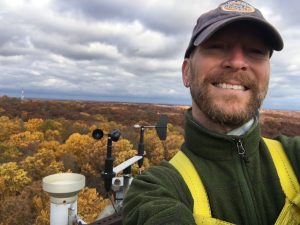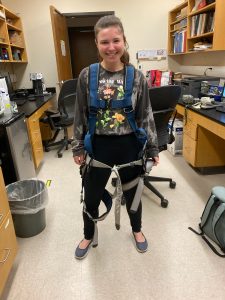As a college undergraduate, my advisor gave me the lofty responsibility of walking up and down the scaffold stairs of an eddy-covariance flux tower. My job was to swap out some data cards and dust cobwebs off the sonic anemometer. Today, I am the technician on nine flux towers across the ecologically diverse New Mexico Elevation Gradient where I do not have the comfort of the scaffold stairs underfoot. Now I have to dust off the sensors without trying to look down! To help with this radical multi-tasking at height, I travelled to Gravitec Systems, Inc. in May 2022 and took the ‘Competent Person and Tower Rescue’ class. After the week-long course, I feel much more comfortable trying to juggle screwdrivers, dusters, and data cards high above the canopy.
Before dusting anemometers, I had never climbed anything of consequence, and I didn’t know my way around a knot or up a rock-wall. Gravitec made me feel comfortable as a beginner, and I found my good habits to be reinforced and my bad habits challenged. Many seasoned climbers who attended the course contributed their own perspectives to the collaborative learning environment, and seemed to take home new skills as well – so yes the course seems great for all experience levels.
Topics ranged from the basic to the advanced. I learned how a proper body harness should fit and how to mitigate bodily trauma in the event of a slip-up. Hint: avoid the slip-ups first! Climbing equipment like carabiners should definitely be engineered for safety and contain ANSI ratings for the job/weight load at hand. While robust, gear does have a shelf life. Paying money for upgrades is better than paying the price (I’m pretty sure that is an original phrase you’re welcome). Pre-climb inspections of my gear and tower infrastructure is not something I take for granted anymore, and I encourage anyone reading to take a closer look for rust, degradation, and general wear from repeated use or even misuse. If you’ve been up and down a tower many times, it appears you have found some comfortable methods of roping in – Nice! Still though, it never hurts to take a second look at how to minimize the sketchy spots. Do you have a secondary anchorage point or lanyard? Can you find an alternative to using that bracket holding the temperature sensor when you need a spot to support your hips? (yeah I’m projecting with that one).
The most surprising (and frightening) aspect of the Gravitec training was dispelling assumptions that I held about tower safety and rescue. I assumed that taking a fall within my harness wouldn’t be overly traumatic. In reality, even short falls have the potential to create thousands of pounds of force. Such force can cause personal injury or overload an insufficient anchor point. At Gravitec, we learned what constitutes a proper anchor and which fall protection gear to use to mitigate these extreme forces.
I also assumed that if anything went awry on a tower, a quick call to 911 would bring emergency professionals to the rescue. Unfortunately, emergency professionals don’t typically have the training or equipment to provide help specific to flux tower emergencies. Additionally, flux towers are often too tall to be reached by ladder trucks and are located in remote areas that complicate access. As tower managers, we truly are dependent on this sort of training to solve rescue situations.
Gravitec tower safety courses are a safe bet whether you are climbing towers regularly or just for periodic maintenance. While a lot of their knowledge and facilities are proprietary – hence the lack of class photos – they do send you home with materials for reference and lasting safety techniques. The class offers lots of hands on practice, interaction with professionals, and hours of practice working harnessed-in at height. I now climb flux towers with a higher level of awareness so I can keep those data cards fresh for years to come!
- Mike Voyles working atop a tower, wearing a potentially life-saving energy absorbing lanyard. Research site: AmeriFlux US-MMS
- Ladder safety system cable (orange circle) for climbing towers; regular inspection of the hardware is a great idea. Avoid relying on this as your “primary” anchor to avoid kinks and other wear. Research site pictured: AmeriFlux US-VCP
- Beware the false sense of security: working on an A-frame ladder is still ‘at height’. This is where most injuries happen! Research site pictured: AmeriFlux US-SES site
- Racheal Auer from the University of New Mexico demonstrates that one size does NOT fit all in a dangerously loose XL-size harness.
About:
Anthony Luketich is a technician for NMEG Core sites cluster in New Mexico) and Mike Voyles is a technician for MMSF Core site cluster in Indiana. Learn more about the AmeriFlux core sites: https://ameriflux.lbl.gov/sites/ameriflux-core-sites/.





No Comments
Be the first to start a conversation